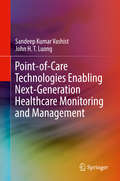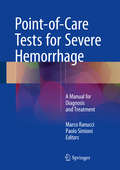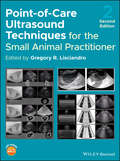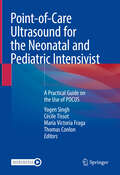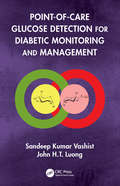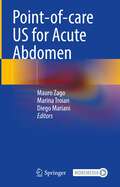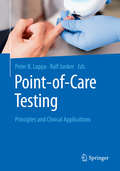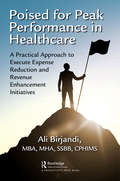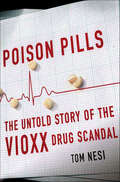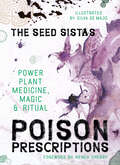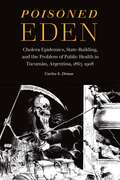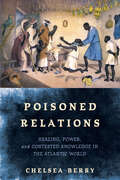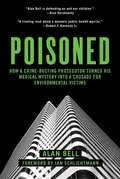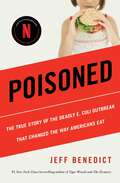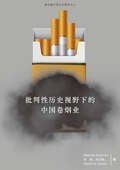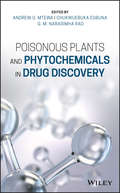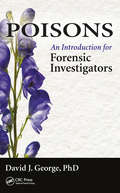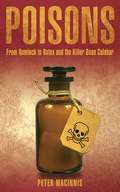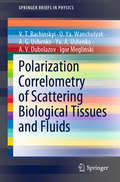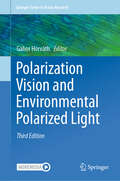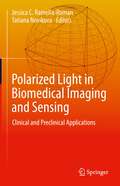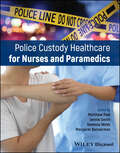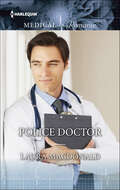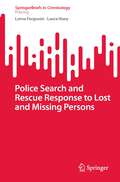- Table View
- List View
Point-of-Care Technologies Enabling Next-Generation Healthcare Monitoring and Management
by Sandeep Kumar Vashist John H.T. LuongThis book describes the emerging point-of-care (POC) technologies that are paving the way to the next generation healthcare monitoring and management. It provides the readers with comprehensive, up-to-date information about the emerging technologies, such as smartphone-based mobile healthcare technologies, smart devices, commercial personalized POC technologies, paper-based immunoassays (IAs), lab-on-a-chip (LOC)-based IAs, and multiplex IAs. The book also provides guided insights into the POC diabetes management software and smart applications, and the statistical determination of various bioanalytical parameters. Additionally, the authors discuss the future trends in POC technologies and personalized and integrated healthcare solutions for chronic diseases, such as diabetes, stress, obesity, and cardiovascular disorders. Each POC technology is described comprehensively and analyzed critically with its characteristic features, bioanalytical principles, applications, advantages, limitations, and future trends. This book would be a very useful resource and teaching aid for professionals working in the field of POC technologies, in vitro diagnostics (IVD), mobile healthcare, Big Data, smart technology, software, smart applications, biomedical engineering, biosensors, personalized healthcare, and other disciplines.
Point-of-Care Testing of COVID-19: Current Status, Clinical Impact, and Future Therapeutic Perspectives (SpringerBriefs in Applied Sciences and Technology)
by Abilash Gangula Brandon Kim Benjamin Casey Allison Hamill Hariharan Regunath Anandhi UpendranThis book highlights the role of point-of-care (POC) testing in the effective management of the coronavirus disease 2019 (COVID-19) pandemic with an in-depth focus on the recent developments in the field, existing gaps, and future directions. POC tests are of utmost importance as they facilitate rapid and decentralized testing without much instrumentation and technical expertise. The book describes the current status of POC COVID-19 testing in three broad categories: Molecular, antigen, and antibody. The advantages, limitations, and adaption of each of the POC tests are reviewed while highlighting their clinical impact in real-world settings. The role of POC testing for COVID-19 screening, diagnosis, and surveillance has been emphasized. The subtle difference between POC and at-home tests is discussed while elaborating on the necessity for the latter for enhancing clinical impacts. A spotlight on the influence of variants on the performance of POC-COVID-19 tests is provided. The consideration of clinical implications of POC testing in hospitals with regards to improving therapeutic options, patient flow, enhancing the infection control measures, and early recruitment of patients into clinical trials is explained. Finally, the future perspectives that will aid the research community in the development of POC tests for COVID-19 or any infectious disease, in general, are presented. Overall, we believe this book can benefit the research community as it (i) presents a comprehensive understanding of current COVID-19 POC testing methods (ii) highlights features required to transform the current tests developed during the past year as POC diagnostics, and (iii) provides insights to address the unmet challenges in the field.
Point-of-Care Tests for Severe Hemorrhage
by Marco Ranucci Paolo SimioniThis book is a rich source of information on point-of-care (POC) tests for the diagnosis and treatment of severe hemorrhage, including thromboelastography, thromboelastometry, heparin monitoring systems, and platelet function analyzers (Multiplate, PFA-100, VerifyNow, etc. ). The opening chapters focus on the pathophysiology of coagulation and the general characteristics of POC devices. The relevance of POC tests in specific scenarios is then carefully explained, with guidance on their use in contexts including trauma, cardiovascular surgery, ECMO, liver surgery, postpartum hemorrhage, and disorders of hemostasis in the critically ill. An individual chapter is devoted to practical issues when applying POC tests, and the book closes by presenting a set of informative clinical cases. As POC devices gain increasing popularity as bedside diagnostic tools in different clinical settings, it is important for practitioners to understand their role and value. Point-of-Care Tests for Severe Hemorrhage will be a useful and reliable source of information for anesthesiologists, intensivists, cardiologists, and hematologists.
Point-of-Care Ultrasound Techniques for the Small Animal Practitioner
by Gregory R. LisciandroThis book offers a thorough revision and update to the first landmark book that presented a standardized approach to focused point-of-care ultrasound exams of the abdomen, thorax, musculoskeletal and eye in veterinary practice. Now incorporating new applications for focused ultrasound exams and additional species, this Second Edition continues to be a state-of-the-art reference for using abbreviated ultrasound exams in clinical practice. A companion website features supplementary video clips of these point-of-care techniques depicting actual ultrasound exams for comparison and comprehension. New chapters in Point-of-Care Ultrasound Techniques for the Small Animal Practitioner, Second Edition cover ultrasound-guided nerve blocks, musculoskeletal, brain imaging, and applications of focused ultrasound techniques in cats, exotics and marine mammals—making it an essential purchase for veterinarians wanting to incorporate point-of-care ultrasound techniques into their veterinary practices. Presents a standardized approach to point-of-care ultrasound as an extension of the physical exam, including trauma, non-trauma, and monitoring applications Includes coverage of new techniques for focused ultrasound exams, including lung, anesthesia and ultrasound guided nerve blocks, transcranial brain imaging, musculoskeletal, volume status evaluation, and rapid assessment for treatable forms of shock Adds cats, exotic and wildlife mammals, and marine mammals to the existing canine coverage Emphasizes the integration of point-of-care ultrasound techniques for optimizing patient care and accurate patient assessment Offers access to a companion website with supplementary video clips showing many clinically relevant didactic examples The second edition of Point-of-Care Ultrasound Techniques for the Small Animal Practitioner is an excellent resource for veterinary practitioners, ranging from the general practitioner to nearly all clinical specialists, including internal medicine, oncology, cardiology, emergency and critical care, anesthesiology, ophthalmology, exotics, and zoo medicine specialists, and veterinary students.
Point-of-Care Ultrasound for the Neonatal and Pediatric Intensivist: A Practical Guide on the Use of POCUS
by Yogen Singh Cécile Tissot María Victoria Fraga Thomas ConlonThis book, written by internationally renowned experts, is a comprehensive text covering all aspects and recommendations regarding the use of POCUS for critically ill neonates and children. Point of Care Ultrasound (POCUS) for the Neonatal and Pediatric Intensivist is structured to address and expand upon recently published international evidence-based POCUS guidelines endorsed by the European Society of Paediatric and Neonatal Intensive Care (ESPNIC). The book is richly illustrated and includes a robust collection of individual POCUS images and cases. The Electronic Supplementary Materials offer high quality and interesting video clips complementing reader learning, particularly for neonatology, pediatric critical care, and general pediatric providers. Chapter authors provide a practical, experience-based approach to clinical integration of POCUS applications and highlight relevant supportive literature as well as important limitations to POCUS use in the management of critically ill children. The information within the book is also intended to support further clinical and educational research in the practice of pediatric POCUS.
Point-of-care Glucose Detection for Diabetic Monitoring and Management
by Sandeep Kumar Vashist John H.T LuongThis book unravels the role of Point-of-Care (POC) glucose monitoring as an essential part of diabetes management. It provides the reader with an in-depth knowledge and understanding of diabetes management, including: <li>the need for POC glucose monitoring <li>the glucose detection technologies (invasive, noninvasive and continuous) being used in the POC devices <li>the analytical performance, characteristics, pros and cons of the POC devices developed to date <li>the importance and role of glycated hemoglobin (HbA1c) monitoring for diabetes management <li>the various POC devices and analyzers for the determination of HbA1c. <P><P>This is the first book to provide complete up-to-date information on POC glucose detection technologies and devices for diabetic monitoring and management. It will be an important reference for healthcare professionals, biomedical engineers, researchers, economists and policy makers. This book also serves as an asset and teaching aid for professionals and researchers in diabetic monitoring and management.
Point-of-care US for Acute Abdomen
by Mauro Zago Marina Troian Diego MarianiThis book focuses on surgical decision-making, a key topic for both surgeons and emergency physicians who are faced with patients with acute abdominal pain. Providing easy-to-understand technical details and discussing the interpretation of normal and pathological images, it is a valuable resource for surgeons and emergency physicians who are not used to applying clinical US in this field, enabling them to shorten the diagnostic path and avoid unnecessary costs and exposure to radiation. It is also a practical reference guide for surgeons and doctors wanting to apply US as a decision-making tool in the context of acute abdominal pain.
Point-of-care testing: Principles and Clinical Applications
by Ralf Junker Peter LuppaThe underlying technology and the range of test parameters available are evolving rapidly. The primary advantage of POCT is the convenience of performing the test close to the patient and the speed at which test results can be obtained, compared to sending a sample to a laboratory and waiting for results to be returned. Thus, a series of clinical applications are possible that can shorten the time for clinical decision-making about additional testing or therapy, as delays are no longer caused by preparation of clinical samples, transport, and central laboratory analysis. Tests in a POC format can now be found for many medical disciplines including endocrinology/diabetes, cardiology, nephrology, critical care, fertility, hematology/coagulation, infectious disease and microbiology, and general health screening. Point-of-care testing (POCT) enables health care personnel to perform clinical laboratory testing near the patient. The idea of conventional and POCT laboratory services presiding within a hospital seems contradictory; yet, they are, in fact, complementary: together POCT and central laboratory are important for the optimal functioning of diagnostic processes. They complement each other, provided that a dedicated POCT coordination integrates the quality assurance of POCT into the overall quality management system of the central laboratory. The motivation of the third edition of the POCT book from Luppa/Junker, which is now also available in English, is to explore and describe clinically relevant analytical techniques, organizational concepts for application and future perspectives of POCT. From descriptions of the opportunities that POCT can provide to the limitations that clinician’s must be cautioned about, this book provides an overview of the many aspects that challenge those who choose to implement POCT. Technologies, clinical applications, networking issues and quality regulations are described as well as a survey of future technologies that are on the future horizon. The editors have spent considerable efforts to update the book in general and to highlight the latest developments, e.g., novel POCT applications of nucleic acid testing for the rapid identification of infectious agents. Of particular note is also that a cross-country comparison of POCT quality rules is being described by a team of international experts in this field.
Poised for Peak Performance in Healthcare: A Practical Approach to Execute Expense Reduction and Revenue Enhancement Initiatives
by Ali BirjandiThe current healthcare system is under attack by market, government, and consumer forces. To stay solvent, organizations must be performing at the top of their game. This book provides detailed instructions to bring organizations to the next level of performance by teaching all the secrets straight from the healthcare consultant’s playbook in less than 100 days. This book defines the coming challenges in the healthcare environment and provides a 10-step solution to develop the infrastructure for peak performance. These solutions include detailed implementation plans, software, reports, metrics, and the top projects that yield the highest financial rewards. This is the first book of its kind to not just discuss the top strategies, but also provide step-by-step instructions to achieve results. The book defines the strategy, the tactics, the infrastructure, the targets, the solutions, the barriers, and the leadership required to achieve a high performing organization. With these simple instructions, any organization with the will to achieve a brighter future can be poised for success in the next decade in less than 100 days.
Poison Pills: The Untold Story of the Vioxx Drug Scandal
by Tom NesiTo the millions of Americans who suffer from chronic pain and arthritis, Vioxx seemed like a miracle. One of the most widely promoted and prescribed pain medications in the world -- used by more than twenty million people -- it was endorsed by the medical establishment and celebrities such as Olympic champion figure skater Dorothy Hamill. With annual sales of $2.5 billion, Vioxx became a pharmaceutical bonanza before being abruptly taken off the market in September 2004, after it was revealed that it led to an increased risk of heart-related disease and death.Drawing on internal documents, video footage, court testimony, and exclusive interviews, as well as three decades of experience inside the medical industry, Tom Nesi tells the dramatic story of what the drug's manufacturer, Merck, knew and when. It is a compelling narrative of business and medical science run amok, with a cast of characters ranging from those at the highest levels of the multibillion-dollar pharmaceutical industry to research scientists, marketers, and drug company sales reps. Here also are accounts from physicians, lawyers, financial analysts, and patients and their families whose lives have been forever altered by Vioxx.Set against a fascinating history of the origins of the modern pharmaceutical industry, POISON PILLS is a shocking tale that involves the breakdown of the United States medical system, the failures of the Food and Drug Administration, and enormous profits made by a large pharmaceutical corporation at the potential cost of thousands of lives.
Poison Prescriptions: Power Plant Medicine, Magic & Ritual
by The Seed SistasPoison Prescriptions is a stunningly illustrated grimoire of some of the most notorious plants: henbane, datura, belladonna, among others. It is also a practical guide to plant magic, medicine and ritual, offering advice to professional and home herbalists, to those interested in forgotten lore and the old ways, and to all those who wish to reclaim control of their own wellbeing.This book urges the resurrection of the ancient tradition of using these witching herbs in ritual and medicine. Now is the time to relink magic and medicine in the context of modern herbalism and contemporary witchcraft.Discover: Safe ways of interacting with the witching herbs to usher in wellbeing and healing.Practical activities ranging from meditations and folklore writing to wreath making and beer brewing.Step-by-step instructions to creating the powerful witches' Flying Ointment and using it in ritual, sex magic and lucid dreaming.
Poisoned Eden: Cholera Epidemics, State-Building, and the Problem of Public Health in Tucumán, Argentina, 1865-1908
by Carlos S. DimasIn 1895, after enduring two previous cholera epidemics and facing horrific hygienic conditions and the fear of another epidemic, officials in the Argentine province of Tucumán described their home as the &“Poisoned Eden,&” a play on its official title, &“Garden of the Republic.&” Cholera elicited fear and panic in the nineteenth century, and although the disease never had the demographic impact of tuberculosis, malaria, or influenza, cholera was a source of consternation that often illuminated dormant social problems. In Poisoned Eden Carlos S. Dimas analyzes the social, political, and cultural effects of three epidemics, in 1868, 1886, and 1895, that shook the northwestern province of Tucumán to understand the role of public health in building the Argentine state in the late nineteenth century. Through a reading of medical and ethnographic material, Dimas shows that cholera became intertwined in all areas of the social fabric and that Tucumanos of all classes created public health services that expanded the state&’s presence in the interior. In each outbreak, provincial powers contended with how to ensure the province&’s autonomy while simultaneously meeting the needs of the state to eradicate cholera. Centering disease, Poisoned Eden demonstrates how public health and debates on cholera&’s contagion became a central concern of the nineteenth-century Latin American state and promoted national cohesion.
Poisoned Relations: Healing, Power, and Contested Knowledge in the Atlantic World (The Early Modern Americas)
by Chelsea BerryIlluminates the competing understandings of poison and power in the Atlantic worldBy the time of the opening of the Atlantic world in the fifteenth century, Europeans and Atlantic Africans had developed significantly different cultural idioms for and understandings of poison. Europeans considered poison a gendered “weapon of the weak” while Africans viewed it as an abuse by the powerful. Though distinct, both idioms centered on fraught power relationships. When translated to the slave societies of the Americas, these understandings sometimes clashed in conflicting interpretations of alleged poisoning events.In Poisoned Relations, Chelsea Berry illuminates the competing understandings of poison and power in the Atlantic World. Poison was connected to central concerns of life: to the well-being in this world for oneself and one’s relatives; to the morality and use of power; and to the fraught relationships that bound people together. The social and relational nature of ideas about poison meant that the power struggles that emerged in poison cases, while unfolding in the extreme context of slavery, were not solely between enslavers and the enslaved—they also involved social conflict within enslaved communities.Poisoned Relations examines more than five hundred investigations and trials in four colonial contexts—British Virginia, French Martinique, Portuguese Bahia, and the Dutch Guianas—bringing a groundbreaking application of historical linguistics to bear on the study of the African diaspora in the Americas. Illuminating competing understandings of poison and power in this way, Berry opens new avenues of evidence through which to navigate the violence of colonial archival silences.
Poisoned: How a Crime-Busting Prosecutor Turned His Medical Mystery into a Crusade for Environmental Victims
by Alan Bell Jan SchlichtmannAfter years of prosecuting hard-core criminals, rising legal star Alan Bell took a private sector job in South Florida’s newest skyscraper. Suddenly, he suffered such bizarre medical symptoms, doctors suspected he’d been poisoned by the Mafia. Bell’s rapidly declining health forced him to flee his glamorous Miami life to a sterile “bubble” in the remote Arizona desert. As his career and marriage dissolved, Bell pursued medical treatments in a race against time, hoping to stay alive and raise his young daughter, his one desperate reason to keep going. He eventually discovered he wasn’t poisoned by a criminal, but by his office building. His search for a cure led him to discover the horrifying truth: his tragedy was just the tip of the iceberg. Millions of people fall ill and die each year because of toxic chemical exposures—without knowing they’re at risk. Stunned by what he discovered, Bell chose to fight back, turning his plight into an opportunity. Despite his precarious health, he began collaborating with scientists dedicated to raising awareness about this issue. Soon, he also found himself drawn back into the legal field, teaming up with top lawyers fighting for those who had already fallen ill. Both a riveting medical mystery and a cautionary tale, this book puts a human face on the hidden truths behind toxic dangers assaulting us in our everyday environments—and offers practical ways to protect ourselves and our children.
Poisoned: The True Story of the Deadly E. Coli Outbreak That Changed the Way Americans Eat
by Jeff BenedictNOW A NETFLIX DOCUMENTARY From Jeff Benedict, the #1 New York Times bestselling author of Tiger Woods and The Dynasty, Poisoned chronicles the events surrounding the worst food-poisoning epidemic in US history: the deadly Jack in the Box E. coli infections in 1993.On December 24, 1992, six-year-old Lauren Rudolph was hospitalized with excruciating stomach pain. Less than a week later she was dead. Doctors were baffled: How could a healthy child become so sick so quickly? After a frenzied investigation, public-health officials announced that the cause was E. coli O157:H7, and the source was hamburger meat served at a Jack in the Box restaurant. During this unprecedented crisis, four children died and over seven hundred others became gravely ill. In Poisoned, award-winning investigative journalist and #1 New York Times bestselling author Jeff Benedict delivers a jarringly candid narrative of the fast-moving disaster, drawing on access to confidential documents and exclusive interviews with the real-life characters at the center of the drama—the families whose children were infected, the Jack in the Box executives forced to answer for the tragedy, the physicians and scientists who identified E. coli as the culprit, and the legal teams on both sides of the historic lawsuits that ensued. Fast Food Nation meets A Civil Action in this riveting account of how we learned the hard way to truly watch what we eat.
Poisonous Pandas: Chinese Cigarette Manufacturing in Critical Historical Perspectives (Studies of the Walter H. Shorenstein Asia-Pacific Research Center)
by Matthew Kohrman, Gan Quan, Liu Wennan, and Robert N. ProctorPlease note that this is a Chinese language edition. A favorite icon for cigarette manufacturers across China since the mid-twentieth century has been the panda, with factories from Shanghai to Sichuan using cuddly cliché to market tobacco products. The proliferation of panda-branded cigarettes coincides with profound, yet poorly appreciated, shifts in the worldwide tobacco trade. Over the last fifty years, transnational tobacco companies and their allies have fueled a tripling of the world's annual consumption of cigarettes. At the forefront is the China National Tobacco Corporation, now producing forty percent of cigarettes sold globally. What's enabled the manufacturing of cigarettes in China to flourish since the time of Mao and to prosper even amidst public health condemnation of smoking? In Poisonous Pandas, an interdisciplinary group of scholars comes together to tell that story. They offer novel portraits of people within the Chinese polity—government leaders, scientists, tax officials, artists, museum curators, and soldiers—who have experimentally revamped the country's pre-Communist cigarette supply chain and fitfully expanded its political, economic, and cultural influence. These portraits cut against the grain of what contemporary tobacco-control experts typically study, opening a vital new window on tobacco—the single largest cause of preventable death worldwide today.
Poisonous Plants and Phytochemicals in Drug Discovery
by Chukwuebuka Egbuna Andrew G. Mtewa G.M. Narasimha RaoFocusing on phytochemicals and their potential for drug discovery, this book offers a comprehensive resource on poisonous plants and their applications in chemistry and in pharmacology. Provides a comprehensive resource on phytotoxins, covering historical perspectives, modern applications, and their potential in drug discovery - Covers the mechanisms, benefits, risks and management protocols of phytotoxins in a scientific laboratory and the usefulness in drug discovery - Written and edited by leading researchers in phytochemistry, medicinal chemistry, analytical chemistry, toxicology, and more - Presents chapters in a carefully designed, clear order, making it an ideal resource for the academic researcher or the industry professional at any stage in their career Provides a comprehensive resource on phytotoxins, covering historical perspectives, modern applications, and their potential in drug discovery Covers the mechanisms, benefits, risks and management protocols of phytotoxins in a scientific laboratory and the usefulness in drug discovery Presents chapters in a carefully designed, clear order, making it an ideal resource for the academic researcher or the industry professional at any stage in their career
Poisons: An Introduction for Forensic Investigators
by David J. GeorgeA unique book on recognition and investigation of criminal poisoning for investigators of all backgrounds and stages of their careers. Poisons: An Introduction for Forensic Investigators is a concise yet comprehensive overview of toxicants and unanticipated circumstances in which poisoning occurs. This book expands awareness of poisoning possibilities, heightens recognition of the toxic potential of many substances, and provides information to aid in focusing investigations. Poisons discusses life-threatening toxic substances and agents that modify behavior to achieve criminal goals. These include drugs that facilitate sexual assaults and robberies, and those found in medical child abuse and drug-product tampering. More than 230 case studies illustrate both unintentional and intentional poisoning and highlight situations where poisoning may not immediately be apparent. Information is included in pertinent criminal poisoning cases to illustrate the temperament of poisoners, their relationship to victims, their basis for poison selection, and their method of administration. Since Poisons is written by a single author, the discussions, format, educational level, and terminology remain consistent to aid crime scene investigators, homicide detectives, forensic scientists, death investigators, toxicologists, medical examiners, attorneys, and students. The book's more than 650 references are an asset to frame knowledge as well as a resource to return to again and again.
Poisons: From Hemlock to Botox and the Killer Bean of Calabar (It's True! Ser. #No. 18)
by Peter MacinnisPoisons permeate our world. They are in the environment, the workplace, the home. They are in food, our favorite whiskey, medicine, and well water. They have been used to cure diseases as well as incapacitate and kill. They smooth wrinkles, block pain, stimulate and enhance athletic ability. In this entertaining and fact-filled book, science writer Peter Macinnis considers poisons in all their aspects. He recounts stories of the celebrated poisoners in history and literature, from Nero to Thomas Wainewright, and from the death of Socrates to Hamlet and Peter Pan. From cyanide to strychnine, from Botox to ricin and Sarin gas-have you ever wondered about their sources? Where do they come from? How do you detect something that can kill you in a matter of seconds? Macinnis methodically analyzes the science of these killing agents and their uses in medicine, cosmetics, war, and terrorism. With wit and precision, he weighs these questions and many more: Was Lincoln's volatility caused by mercury poisoning? Was Jack the Ripper an arsenic eater? Can wallpaper kill? For anyone who has ever wondered and been afraid to ask, here is a rich miscellany for your secret questions about toxins.
Polarization Correlometry of Scattering Biological Tissues and Fluids (SpringerBriefs in Physics)
by V. T. Bachinskyi O. Ya. Wanchulyak A. G. Ushenko Yu. A. Ushenko A. V. Dubolazov Igor MeglinskiThis book presents a new diagnostic approach that utilizes complex statistical, correlation, fractal, and singular analysis of spatial distribution of the Stokes vector of scattered polarized light in different diffraction zones. The technique is able to identify changes in the distribution of optical axes and the birefringent indices of multi-layered fibrillar networks of biological tissues. The book also presents various scenarios for the formation of polarization singularities in laser speckle images of phase-inhomogeneous, multi-layered biological tissues in terms of the characteristic values of Mueller-matrix images. Moreover, in the context of potential diagnostic applications, it discusses the states of polarization singularities and their changes associated with the pathological abnormalities of the extracellular matrix of human tissues, its spatial peculiarities and structural orientation.
Polarization Vision and Environmental Polarized Light (Springer Series in Vision Research)
by Gábor HorváthThis new edition presents a state-of-the-art exploration of polarized light and polarization vision. Part I of the book examines polarization sensitivity across many animal taxa, including invertebrates and vertebrates, and it details both terrestrial and aquatic life. Part II is devoted to the description of environmental polarization with implications to animal and human polarization vision. This includes underwater polarization, polarization signals, sky-polarimetric Viking navigation and astronomical polarization. This part also examines polarized light pollution induced by anthropogenic factors, such as reflection off asphalt surfaces, glass panes, car bodies, and other man-made structures that are now known to form ecological traps for polarotactic insects. The new edition features a number of novelties, including chapters on trilobites, springtails, bats, seals, imaging polarimetry, and astronomical polarization.
Polarized Light in Biomedical Imaging and Sensing: Clinical and Preclinical Applications
by Tatiana Novikova Jessica C. Ramella-RomanThis book focuses on biomedical applications of polarized light, covering instrumentation and modeling specific to the field. This will be the first book, written by leading researchers in the field, to tackle this important topic. Readers will learn the fundamentals of polarized light transport and how to develop instrumentation for clinical and preclinical studies. They will also become familiar with the latest advancement in data analysis and image processing for a variety of medical applications. The book is dedicated specifically to the biomedical community, including scientists, engineers, and physicians working on the development of instrumentation for clinical and preclinical use.Emphasizes biomedical imaging and sensing;Describes new computational approaches with examples;Provides detailed descriptions of novel instrumentation.
Police Custody Healthcare for Nurses and Paramedics
by Jennie Smith Matthew Peel Vanessa Webb Margaret BannermanAn essential resource for nurses and paramedics navigating the intricate world of police custody, providing a solid guide for both the novices and the veterans in the field Across the UK there are on average over 750,000 episodes of police detentions annually, the equivalent of over 2,000 a day. Each one is entitled to healthcare comparable to the wider community. It is estimated on average 54% of these detained individuals are referred to a healthcare professional because of a complex mix of physical health, mental health, medication, substance misuse or social issues. Healthcare professionals working in custody must navigate this complex mix while working within a short-term detention setting. Police Custody Healthcare for Nurses and Paramedics offers a thorough, accessible introduction to this subject and its key aspects. Nurses and paramedics working in police custody healthcare settings will find a volume that addresses their specific needs, with guidelines for understanding initial patient contact, potential comorbidity, mental illness, forensic sampling, documenting injuries, writing statements, and much more. Aligned to the UK Association of Forensic Nurses and Paramedics’ Advanced Standards in Education and Training (ASET), this is a must-have resource for professionals in this growing area of practice. Readers will also find: The first text written specifically for nurses and paramedics by nurses and paramedics with extensive experience in police custodyDetailed discussion of topics including fitness assessment, medicines management, use of force restraints, and much morePedagogical tools including self-assessment questions, case studies, and learning outcomes Police Custody Healthcare for Nurses and Paramedics is ideal for trainee or registered nurses and paramedics working in police custody healthcare settings or other detention settings.
Police Doctor
by Laura MacDonaldDr. Adele Brooks isn't pleased about an unexpected change of boss on her first day at Stourbourne Abbas, and general practitioner and local police surgeon Casey is even less delighted about suddenly being landed with a trainee to look after!Despite this initial antagonism, Adele finds herself drawn to this enigmatic, hardworking doctor. But what she discovers about Casey's past and present makes him completely off-limits to her. When the challenges of their police work bring them even closer together Adele has to fight the incredible attraction between them….
Police Search and Rescue Response to Lost and Missing Persons (SpringerBriefs in Criminology)
by Laura Huey Lorna FergusonThis brief discusses the significant contribution of police search and rescue to the successful location and resolution of missing persons cases. Across seven chapters, this volume offers a detailed examination of the routine practices of police search and rescue personnel. To do so, it draws from a collection of data, including in-depth interviews with police and thousands of different types of missing persons records. Laced with the stories of missing persons, it presents a detailed overview of what these teams do, the processes and procedures employed, and the tools and technologies in police search and rescue. It explores some of the challenges impacting police search and rescue response, emphasizing how to leverage this work in the field. This book also identifies future trends to address the “What may be next” question in the police search and rescue response to missing persons. As the first analysis of the role of police in search and rescue missions, this brief is of interest to law enforcement professionals and researchers of policing, policymakers, and professionals in psychology, criminology, sociology, and beyond
